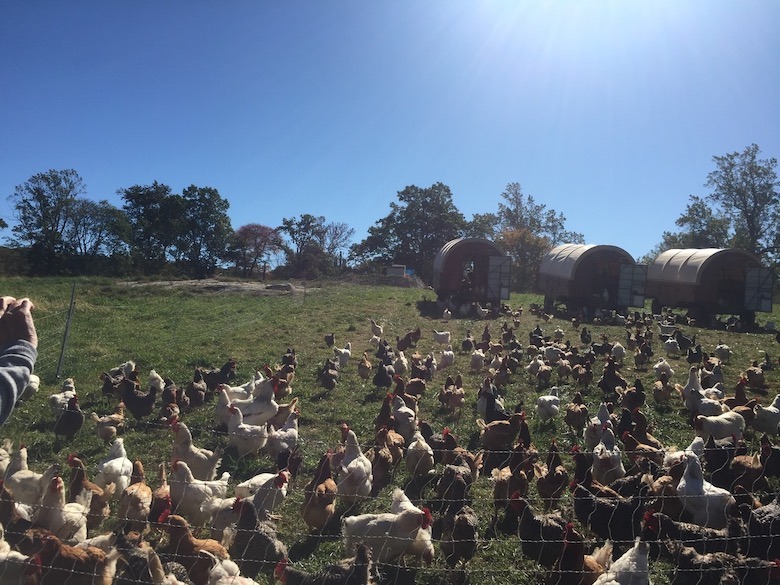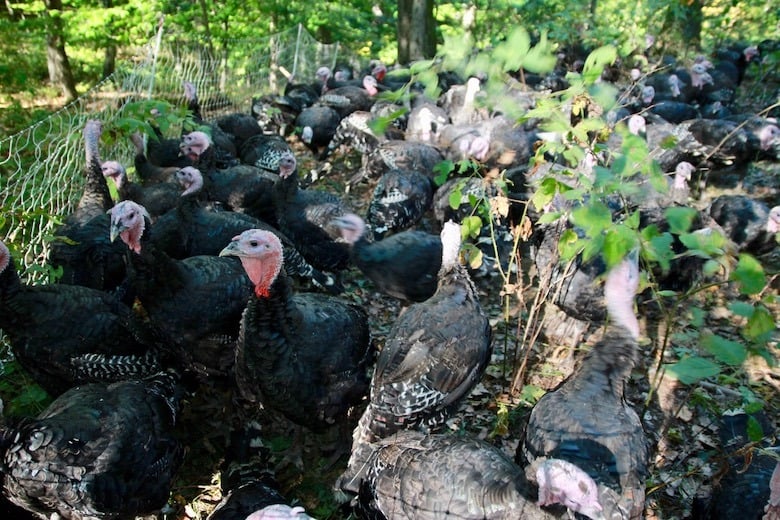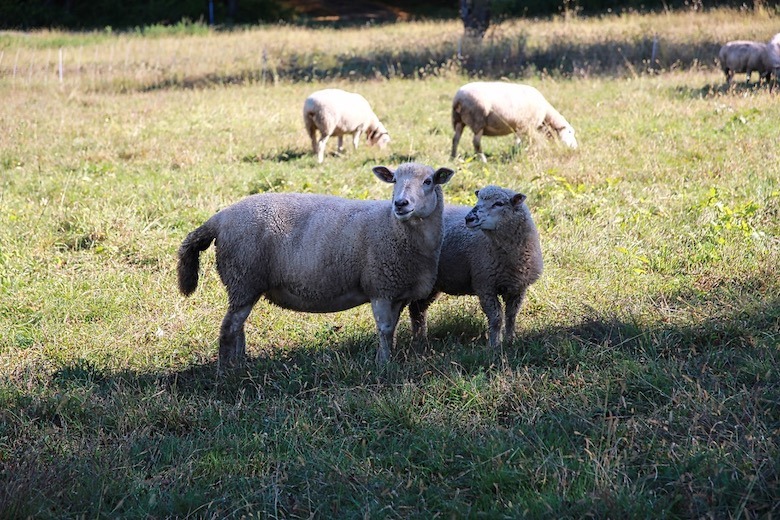A Day in the Life of a Stone Barns Livestock Farmer
We had the unique pleasure of visiting Stone Barns Center for Food and Agriculture this past fall to learn all about their hard work raising forest-foraging turkeys (read all about our visit here) and the variety of ways they keep sustainability and animal welfare at top of mind. We were so impressed with their approach to turkey rearing that we wanted the inside scoop on the rest of the farm. So we spoke with Phil Haynes, Rangeland Manager, about all of the intricate details that go into a day in the life at Stone Barns to better understand the hard work that goes into animal husbandry.
Stone Barns raises egg-laying and meat chickens, ducks, turkeys, sows, piglets, hogs, sheep and livestock guardian dogs. A typical day involves several visitations to each breed, to shift their enclosures into outdoor space (and then to return them to safety at night), and to ensure they are fed and have ample fresh water.
We followed Phil around for a day to meet the animals and hear about the noble work being done at Stone Barns. There’s a tremendous amount of work that goes on behind the scenes to raise these animals responsibly, so we hope to offer you all a small window into the comings and goings of a Stone Barns livestock farmer through a series of photographs taken by both our team at GRACE and Phil himself.

8:04 AM
A day in the life of Phil Haynes starts bright and early. First things first, the staff (including Phil, the livestock assistant and two apprentices) check on egg laying chickens that are on pasture. The team is very intentional about making sure to move the chicken coop daily so that there is an even dispersal of manure throughout the area of grass. These birds are very productive! Each day, Phil and his team collect about 250 eggs total, which are then distributed to the market store.
Simultaneously, a member of the grounds crew heads down to let the feeder pigs outside, where they enjoy a full eight hours in a canopied, wooded area.
8:34 AM
Up next, it’s time to check on the brooder barn houses which shelter the juvenile animals, primarily day-old ducklings and chicks the farm receive every two weeks. During this check-in, the team makes sure the ducklings have ample amounts of fresh water, feed and bedding. This is also an opportunity for the team in check on the ducklings’ overall health and be sure none of them are sick. If they discover any illnesses, they administer the necessary antibiotics into some water and quarantine the sick bird. In the unfortunate case that a bird dies, they send it to the lab to learn the cause of death with the hope of further equipping themselves with knowledge to avoid illnesses and fatalities moving forward.
9:10 AM
By around 9 AM, it’s time to visit the older ducks in the barnyard. A member of the team herds the 75 to 80 ducks out in a flock into the pasture, where they enjoy a day of free wandering, and are only kept in the barn overnight to protect them from predators.
9:25 AM
After the ducks are all corralled and settled, the crew moves on to feed the sows. The sows are certainly sizable at 400+ pounds — and wow, can they eat! For breakfast, each sow gets two and a half pounds of grain.

In summertime rotations, there are typically around nine babies to feed and monitor as well, making sure they are growing and staying healthy.
9:38 AM
Visiting with the turkeys was a highlight of our visit this past fall. After tending to the sows, Phil and his team go to the turkey barn to herd the birds from their nighttime enclosure out into the woods. If you’ve ever spent a good deal of time around turkeys, you know it’s quite impossible to keep them herded and together; this visit requires all hands on deck. Turkeys prefer to graze in canopied, wooded areas. When shrouded beneath the trees, the birds are less worried about evading overhead predators and instead maintain low levels of stress.

It’s also quite challenging to herd chickens. So, the meat chickens stay on pasture because they don’t herd well. This approach doesn’t sacrifice safety, though. Instead, Stone Barns uses charged portable net fencing as well as a dog on the pasture to protect them from coyotes. This combination of safety measures makes for happy, stress-free chickens!
10:11 AM
The team is covering a good deal of ground, in all sorts of weather conditions! After a few hours of making the rounds, they make sure to hydrate in an effort to gear up for the next phase.
10:24 AM
Once they’re back on their feet, Phil and the crew go to check up on the pigs who live at the compost pad, about 20 in all. They open the gate that guides them down a corridor into the woods, which is their daytime area. Similar to turkeys, pigs natural habitat is in the woods, where there is cool dense canopy and understory of natural forages. If restricted to open areas without shade or mud, pigs will become very stressed because they lack sweat glands to cool themselves down.
11:02 AM
It’s time to make the small trek to the sheep! They are the furthest away, so the team hops on the utility vehicle to make their way over. They are primarily making sure that the sheep have sufficient amounts of grass to continue grazing. If not, they move the paddock and make a new space for them. At Stone Barns, they have anywhere from 50 to 150 sheep over the course of the year, with around 70 different spaces that the sheep rotate through. So, as you can imagine, checking up on them and herding them to fresh grass areas can be a big undertaking. In this rotation, the team has to visit both groups of sheep, the lambs and the ewes, and move them. Luckily, for the moments that the livestock team isn’t around, they can be sure that their sheep are safe and calm, thanks to the watchful presence of the guard dogs. These helpful, dedicated canines are a natural safety measure, and as you can see by Stanley’s wagging tail, he’s happily up to the task!
12:01 PM
Time to fuel up with some lunch.
1:00 PM
After covering the span of the grounds all morning, it’s time to circle back to make sure all of the animals are well-fed, well-hydrated and content overall. Phil starts by making his way back to the egg-laying chickens, and then proceeds to visit and monitor the ducklings in the barnyard. (As you can imagine from the video below, Phil completes this task with zero complaints!)
2:04 PM
Phil heads back to the compost area to feed the feeder pigs. They’ve been out and about all morning and afternoon working up an appetite — and they’re in luck! Each day, the pigs eat a combination of things from the waste stream, including spent brewers grain from the local brewery, Captain Lawrence, and pre-consumer waste from the restaurant: vegetable peelings, seeds, grains, sauces, cooked foods, bread, field scraps and dairy beyond the sell-by date. The team is intentional about making sure there is plenty of food laid out before the pigs make their way back in, so none of the animals are scrambling or in competition with one another to get nourishment.
2:31 PM
Once the pigs are fed and enclosed, they circle back to check on the turkeys in the forested area and bring them back into their barnyard where they rest protected overnight.
3:26 PM
Check on the ducks and bring them back into their barnyard.
4:04 PM
Visit the chickens that are on pasture and check their food and water supply, in addition to feeding the dog. Not all animals that are raised make it to the dinner table, so in order to avoid waste and also reward the dogs for their hard work, they are fed raw meat from time to time. The meat is good for their joints and eyes, which are vital assets in the hard work required for a guard dog. It’s also important to note that they are never fed meat that is from the species they’re guarding.
5:00-6:00 PM
Just like with the visit to the chickens, the crew makes the rounds to the dogs that are protecting the sheep to feed them as well.

8:01 PM: Nighttime Rounds
Phil heads back out into the field, first to the barnyard and rolls down the brooder barn doors, then to the turkey barn to close up those doors, before finally sealing the duck barn doors. During this visit, he triple checks that all animals are content and protected overnight for resting.
8:32 PM
As a final leg on the daylong journey, Phil heads out to the pasture to check on the egg-laying chickens and shut them in their mobile coop doors. It’s been quite a day, and with everyone all tuckered away in their enclosures, it’s time for some sleep (certainly for Phil and the team, too!).
Keep up with and support the hard work being done at Stone Barns on Instagram, Twitter and Facebook!
More Reading
Meet muscadines, the native grapes of the southern U.S.
April 1, 2024
Eat more grains — and keep it local
September 29, 2023
Why We Love Photographing Our Farmers' Market Hauls
August 9, 2023
Georgia’s Peach Crop Loss Is About More Than Just Fruit
August 7, 2023
6 Recipes for Seasonal Drinks Inspired by Summer’s Bounty
June 28, 2023
Get to Know These 9 Types of Mustard Greens
June 14, 2023
The Movement to Revive Local Grains — and the Infrastructure Required to Keep It Going
June 12, 2023
A Guide to Winter Citrus Varieties
February 1, 2023
Get to Know Collard Greens
January 18, 2023
Coming Soon: More Native Foods in the National School Lunch Program
January 11, 2023
